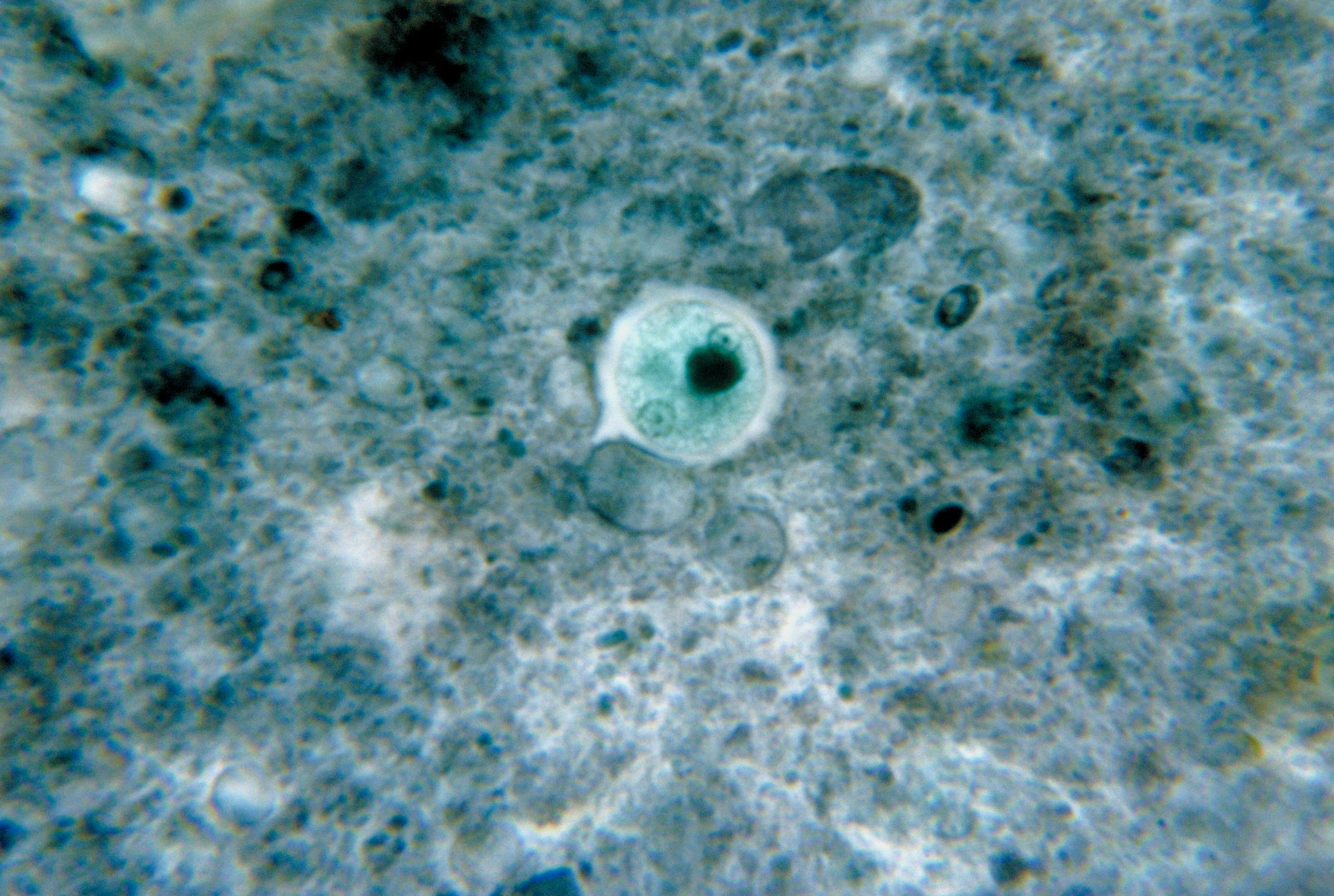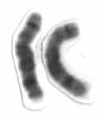|
Iodoquinol
The quinoline derivative diiodohydroxyquinoline ( INN), or iodoquinol ( USAN), brand name Diodoquin, can be used in the treatment of amoebiasis. It is poorly absorbed from the gastrointestinal tract and is used as a luminal amebicide. It acts by chelation of ferrous ions essential for metabolism. It was discovered by Adco Co. and introduced as ''diiodohydroxyquinoline''. Susceptibility of '' Dientamoeba fragilis'' has been measured. Iodoquinol is an amebicide used against ''Entamoeba histolytica'', and it is active against both cyst A cyst is a closed sac, having a distinct envelope and division compared with the nearby tissue. Hence, it is a cluster of cells that have grouped together to form a sac (like the manner in which water molecules group together to form a bubb ... and trophozoites that are localized in the lumen of the intestine. It is considered the drug of choice for treating asymptomatic or moderate forms of amebiasis. The full mechanism of action is unkno ... [...More Info...] [...Related Items...] OR: [Wikipedia] [Google] [Baidu] |
Amoebiasis
Amoebiasis, or amoebic dysentery, is an infection of the intestines caused by a parasitic amoeba '' Entamoeba histolytica''. Amoebiasis can be present with no, mild, or severe symptoms. Symptoms may include lethargy, loss of weight, colonic ulcerations, abdominal pain, diarrhea, or bloody diarrhea. Complications can include inflammation and ulceration of the colon with tissue death or perforation, which may result in peritonitis. Anemia may develop due to prolonged gastric bleeding. Cysts of ''Entamoeba'' can survive for up to a month in soil or for up to 45 minutes under fingernails. Invasion of the intestinal lining results in bloody diarrhea. If the parasite reaches the bloodstream it can spread through the body, most frequently ending up in the liver where it can cause amoebic liver abscesses. Liver abscesses can occur without previous diarrhea. Diagnosis is made by stool examination using microscopy, but it can be difficult to distinguish ''E. histolytica'' ... [...More Info...] [...Related Items...] OR: [Wikipedia] [Google] [Baidu] |
Entamoeba Histolytica
''Entamoeba histolytica'' is an anaerobic organism, anaerobic parasitic amoebozoan, part of the genus ''Entamoeba''. Predominantly infecting humans and other primates causing amoebiasis, ''E. histolytica'' is estimated to infect about 35-50 million people worldwide. ''E. histolytica'' infection is estimated to kill more than 55,000 people each year. Previously, it was thought that 10% of the world population was infected, but these figures predate the recognition that at least 90% of these infections were due to a second species, ''E. dispar''. Mammals such as dogs and cats can become infected transiently, but are not thought to contribute significantly to transmission. The word ''histolysis'' literally means disintegration and dissolution of organic tissues. Transmission The active (trophozoite) stage exists only in the host and in fresh loose feces; Microbial cyst, cysts survive outside the host in water, in soils, and on foods, especially under moist conditions on the lat ... [...More Info...] [...Related Items...] OR: [Wikipedia] [Google] [Baidu] |
Quinoline
Quinoline is a heterocyclic aromatic organic compound with the chemical formula C9H7N. It is a colorless hygroscopic liquid with a strong odor. Aged samples, especially if exposed to light, become yellow and later brown. Quinoline is only slightly soluble in cold water but dissolves readily in hot water and most organic solvents. Quinoline itself has few applications, but many of its derivatives are useful in diverse applications. A prominent example is quinine, an alkaloid found in plants. Over 200 biologically active quinoline and quinazoline alkaloids are identified. 4-Hydroxy-2-alkylquinolines (HAQs) are involved in antibiotic resistance. Occurrence and isolation Quinoline was first extracted from coal tar in 1834 by German chemist Friedlieb Ferdinand Runge; he called quinoline ''leukol'' ("white oil" in Greek). Coal tar remains the principal source of commercial quinoline. In 1842, French chemist Charles Gerhardt obtained a compound by dry distilling quinine, st ... [...More Info...] [...Related Items...] OR: [Wikipedia] [Google] [Baidu] |
United States Adopted Name
A United States Adopted Name (USAN) is a unique nonproprietary name assigned to a medication marketed in the United States. Each name is assigned by the USAN Council, which is co-sponsored by the American Medical Association (AMA), the United States Pharmacopeial Convention (USP), and the American Pharmacists Association (APhA). The USAN Program states that its goal is to select simple, informative, and unique nonproprietary names (also called generic names) for drugs by establishing logical nomenclature classifications based on pharmacological or chemical relationships. In addition to drugs, the USAN Council names agents for gene therapy and cell therapy, contact lens polymers, surgical materials, diagnostics, carriers, and substances used as an excipient. The USAN Council works in conjunction with the World Health Organization (WHO) international nonproprietary name (INN) Expert Committee and national nomenclature groups to standardize drug nomenclature and establish rule ... [...More Info...] [...Related Items...] OR: [Wikipedia] [Google] [Baidu] |
Gastrointestinal Tract
The gastrointestinal tract (GI tract, digestive tract, alimentary canal) is the tract or passageway of the Digestion, digestive system that leads from the mouth to the anus. The tract is the largest of the body's systems, after the cardiovascular system. The GI tract contains all the major organ (biology), organs of the digestive system, in humans and other animals, including the esophagus, stomach, and intestines. Food taken in through the mouth is digestion, digested to extract nutrients and absorb energy, and the waste expelled at the anus as feces. ''Gastrointestinal'' is an adjective meaning of or pertaining to the stomach and intestines. Nephrozoa, Most animals have a "through-gut" or complete digestive tract. Exceptions are more primitive ones: sponges have small pores (ostium (sponges), ostia) throughout their body for digestion and a larger dorsal pore (osculum) for excretion, comb jellies have both a ventral mouth and dorsal anal pores, while cnidarians and acoels have ... [...More Info...] [...Related Items...] OR: [Wikipedia] [Google] [Baidu] |
Chelation
Chelation () is a type of bonding of ions and their molecules to metal ions. It involves the formation or presence of two or more separate coordinate bonds between a polydentate (multiple bonded) ligand and a single central metal atom. These ligands are called chelants, chelators, chelating agents, or sequestering agents. They are usually organic compounds, but this is not a necessity. The word ''chelation'' is derived from Greek χηλή, ''chēlē'', meaning "claw"; the ligands lie around the central atom like the claws of a crab. The term ''chelate'' () was first applied in 1920 by Sir Gilbert T. Morgan and H. D. K. Drew, who stated: "The adjective chelate, derived from the great claw or ''chele'' (Greek) of the crab or other crustaceans, is suggested for the caliperlike groups which function as two associating units and fasten to the central atom so as to produce heterocyclic rings." Chelation is useful in applications such as providing nutritional supplements, in chel ... [...More Info...] [...Related Items...] OR: [Wikipedia] [Google] [Baidu] |
Ferrous Ion
In chemistry, iron(II) refers to the element iron in its +2 oxidation state. The adjective ''ferrous'' or the prefix ''ferro-'' is often used to specify such compounds, as in ''ferrous chloride'' for iron(II) chloride (). The adjective ''ferric'' is used instead for iron(III) salts, containing the cation Fe3+. The word ''ferrous'' is derived from the Latin word , meaning "iron". In ionic compounds (salts), such an atom may occur as a separate cation (positive ion) abbreviated as Fe2+, although more precise descriptions include other ligands such as water and halides. Iron(II) centres occur in coordination complexes, such as in the anion ferrocyanide, , where six cyanide ligands are bound the metal centre; or, in organometallic compounds, such as the ferrocene , where two cyclopentadienyl anions are bound to the FeII centre. Ferrous ions in biology All known forms of life require iron. Many proteins in living beings contain iron(II) centers. Examples of such metalloproteins ... [...More Info...] [...Related Items...] OR: [Wikipedia] [Google] [Baidu] |
Dientamoeba Fragilis
''Dientamoeba fragilis'' is a species of single-celled excavates found in the gastrointestinal tract of some humans, pigs and gorillas. It causes gastrointestinal upset in some people, but not in others. It is an important cause of traveller's diarrhoea, chronic diarrhoea, fatigue and, in children, failure to thrive. Despite this, its role as a "commensal, pathobiont, or pathogen" is still debated. ''D. fragilis'' is one of the smaller parasites that are able to live in the human intestine. ''Dientamoeba fragilis'' cells are able to survive and move in fresh feces but are sensitive to aerobic environments. They dissociate when in contact or placed in saline, tap water or distilled water. Etymology * Di refers to the two nuclei in the trophozoites (feeding stage of the organism). * Ent refers to the enteric environment in which the organism is found. * The species name ''fragilis'' refers to the fact that the trophozoite stages are fragile; they do not survive long in the stool a ... [...More Info...] [...Related Items...] OR: [Wikipedia] [Google] [Baidu] |
Microbial Cyst
A microbial cyst is a resting or dormant stage of a microorganism, that can be thought of as a state of suspended animation in which the metabolic processes of the cell are slowed and the cell ceases all activities like feeding and locomotion. Many groups of single-celled, microscopic organisms, or microbes, possess the ability to enter this dormant state. Encystment, the process of cyst formation, can function as a method for dispersal and as a way for an organism to survive in unfavorable environmental conditions. These two functions can be combined when a microbe needs to be able to survive harsh conditions between habitable environments (such as between hosts) in order to disperse. Cysts can also be sites for nuclear reorganization and cell division, and in parasitic species they are often the infectious stage between hosts. When the encysted microbe reaches an environment favorable to its growth and survival, the cyst wall breaks down by a process known as excystation. E ... [...More Info...] [...Related Items...] OR: [Wikipedia] [Google] [Baidu] |
Acrodermatitis Enteropathica
Acrodermatitis enteropathica is an autosome, autosomal dominance (genetics), recessive metabolic disorder affecting the uptake of Zinc in biology, zinc through the inner lining of the bowel, the mucous membrane. It is characterized by inflammation of the skin (dermatitis) around bodily openings (periorificial) and the tips of fingers and toes (acral), hair loss (alopecia), and diarrhea. It can also be related to deficiency of zinc due to other, i.e. congenital causes. Other names for ''acrodermatitis enteropathica'' include Brandt syndrome and Danbolt–Cross syndrome. Signs and symptoms Individuals with acrodermatitis enteropathica may present with the following: * Blistering of skin * Dry skin * Emotional lability * Glossitis * Pustule Alopecia (loss of hair from the scalp, eyebrows, and eyelashes) may occur. Skin lesions may be secondarily infected by bacteria such as ''Staphylococcus aureus'' or fungus, fungi such as ''Candida albicans''. These skin lesions are accompanied by ... [...More Info...] [...Related Items...] OR: [Wikipedia] [Google] [Baidu] |




